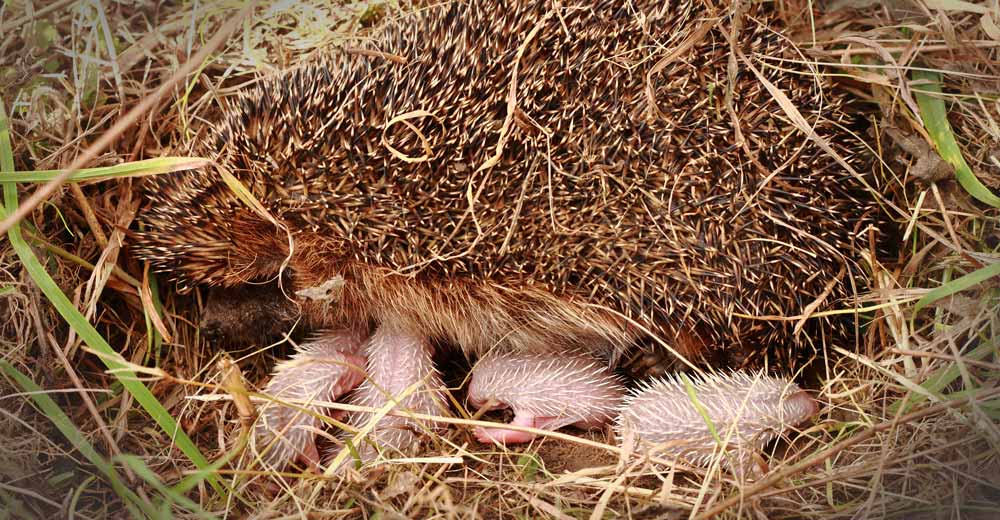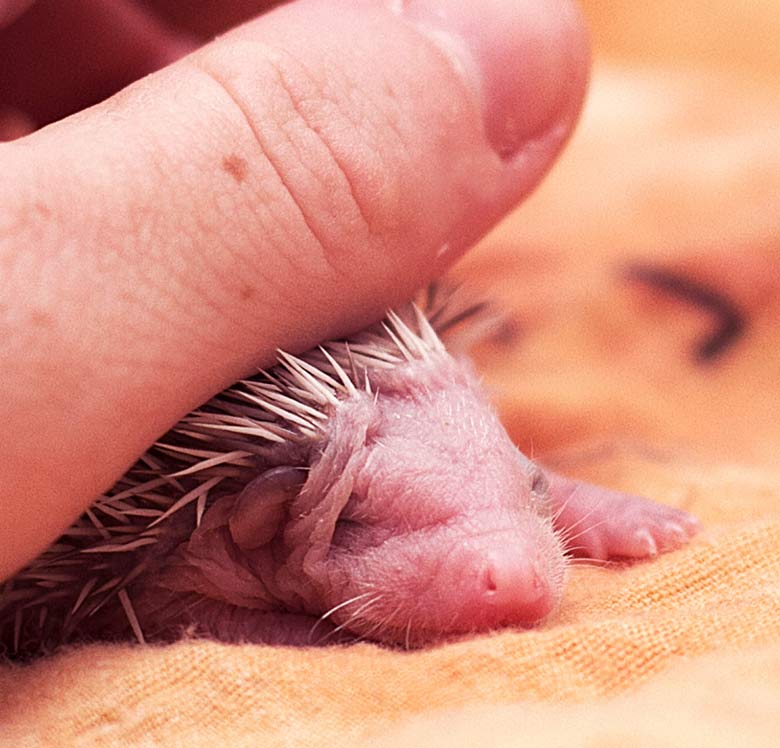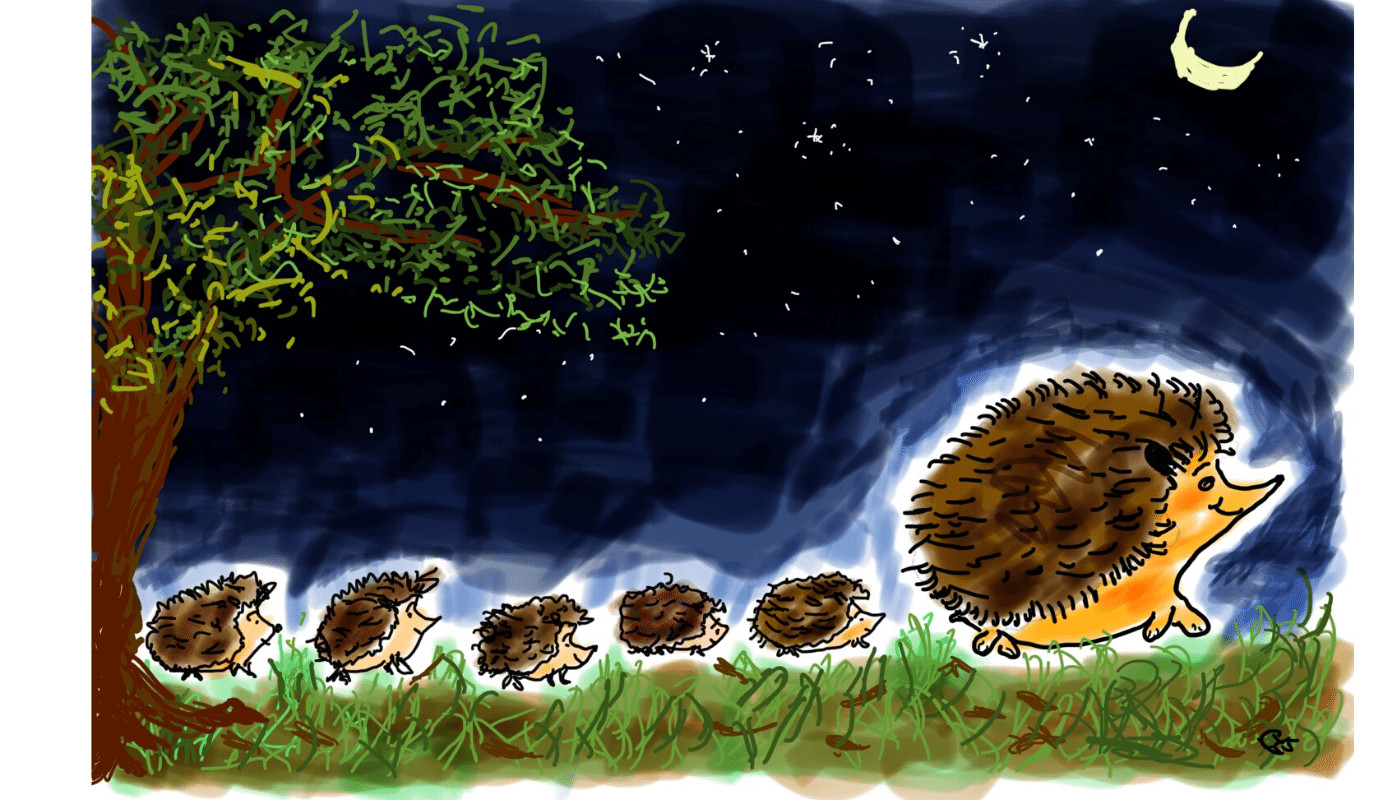Baby hedgehogs, called Hoglets, are born in the UK in June and July. A second litter may be born in September or October. They are usually 4 or 5 hoglets in a litter. Newborn hoglets are blind and tiny, weighing just 25 grams. When they are born, baby hedgehogs have no visible spines.
Baby Hedgehogs – When, Where and How?
Hedgehog numbers in the UK are declining rapidly. So the sight of a mother leading a little procession of baby hogs out on their first foraging trip is a delight for anyone interested in wildlife.
It signals the start of a new generation and gives new hope for the future of the species.
But being a baby hedgehog is a risky business. Maybe only half of the hedgehogs born in the UK make it to maturity.
The better we understand hedgehog mating and hoglet-rearing, the more we can help our local hoglets make it through to healthy adulthood.
So in this article, we are going to cover:
- the hedgehog mating season.
- pregnancy and birth.
- hoglet development and family life.
- dangers for baby hedgehogs.
- how to help a baby hedgehog.
So read on for all you need to know about this most exciting time in the hedgehog year.

When are Baby Hedgehogs Born?
The Hedgehog Mating Season.
Before we start thinking about when hoglets are born, we need to go back a step and take a look at when, and how, they are made.
Hedgehogs come out of hibernation in March or April and quickly start the process of fattening up for the mating season.
Mating starts in April and can go on until September. The main activity though takes place in May and June.
It’s a noisy business, and if you have hogs in your garden, this is undoubtedly a time when you will know they are around, even if you don’t see them.
The courtship ritual isn’t all that romantic.
The male hog finds a female and starts to circle round her. She will give him the cold shoulder, turning her side to him so he can’t approach. Whilst at the same time putting him off with plenty of grunting and snorting noises.
All this noise quite often attracts the attention of other males who may then approach to try their luck. If this happens the two males will have a bit of a tussle, head butting and jostling each other. Sometimes one or other wins and goes back to the female.
Other times the female gets bored and wanders off, leaving the males to it!
The mating dance can go on for hours but eventually ends quite suddenly, either with one of the hogs running off or when mating starts.
Mating for hedgehogs is an extremely prickly business – think sharp spines meeting soft underbelly – ouch!
So mating can only happen with the full cooperation of both hogs. The female must lie flat to the ground arching her head and shoulders, so she almost looks like she’s doing yoga.
This way her spines lie flat and the male can safely climb on board, grasping the spines between her shoulder blades with his teeth and using his paws to get a better grip.
At any time during the process, the female can change her position so she “bristles” and throws the male off.
Even after all this mating is not guaranteed to lead to pregnancy
So hedgehogs do lots of mating, with lots of different partners just to be sure. Two a night is not unusual, and a hog may have ten or 12 different partners during the mating season according to Pat Morris in his great book “Hedgehogs”.
Hedgehogs are generally solitary creatures, and mating doesn’t change this. After the act, there seems to be no pair bond formed at all. The male goes on his way and takes no part in raising the litter. There is little chance he would ever recognise his offspring.
Pregnancy and Giving Birth
Female hedgehogs are usually pregnant for around 32 days before giving birth.
But pregnancy can go on for quite a bit longer. This is very unusual in mammals. It is thought that pregnancy is extended when the weather turns cold after the female becomes pregnant, pushing her back into hibernation. When this happens, the pregnancy and development of the embryo will be put “on hold” and start up again when the mother comes back out of hibernation.
During the pregnancy, the female will be kept busy building a nursery nest.
The nursery nest is similar to the hibernaculum where hedgehogs spend the winter. It’s just bigger, to allow room for the hoglets, and a bit more untidy. Where leaves are the primary building material for a hibernaculum, a nursery nest is made of all sorts of bits the hog picks up including paper and bits of rubbish. As it’s not so cold at nursing time, the hog doesn’t need to be quite as careful about making sure the nest is well insulated.
When the female gives birth she will usually produce a litter of 4 or 5 hoglets. Bigger litters do happen, but having a bigger litter seems to reduce the individual hoglets chances of making it to adulthood.

Baby Hedgehog less than 1 week old, with eyes closed and white spines.
When baby hedgehogs are born, they are tiny, just 25 grams or one ounce in weight. They are born blind.
No spines are visible when they are born – which is when you think about it is probably a very good thing for the mother.
The new-born hogs are covered in greyish skin over a layer of liquid, a bit like a water blister. This skin serves to protect the mother during birth and quickly retracts as the hoglets grow.
Hoglet Development and Family Life
Baby Hedgehogs are only with their mother for around six weeks, and in this time they must develop from tiny, blind, spineless infants into independent young hogs.
It’s a hectic time in the hedgehog’s life cycle.
During the first few hours after birth, the hoglets covering of skin retracts to reveal pure white spines, about 100 of them, with a centre parting.
Over the next few weeks the brown spines we are more used to seeing grow up through the white ones. As more and more brown spines grow, the white ones become almost invisible and will eventually be lost through moulting.
Baby hedgehogs feed on mothers milk, just like humans. The mother has two sets of five nipples. This would allow her to feed a huge litter of 10 in theory. In practice, though, she is unlikely to have enough milk to feed more than 4 or 5 hoglets properly.
The babies will start to eat solids at around three weeks. Mum will generally chew up bits of food and offer them to the hoglets in small, softened portions.
Hoglets are born with milk teeth, just like humans. They will start to get their first adult teeth at three weeks old and lose their final milk teeth at around three months.
Baby hedgehogs are born a pale pink colour, and over the first few weeks of life, fur grows, and the skin gradually darkens as the brown spines come through.
By four weeks old the hoglets will look just like miniature hedgehogs and will be ready to leave the nest with Mum to go on foraging trips. These first trips out of the nest are one of the most perilous times for hoglets.
Hoglets typically spend just two or three weeks out and about with Mother before going off on their own.
As they are mostly solitary creatures, siblings don’t tend to hang around with one another once they have left the nest. Father plays no part in the raising of the hoglets, and it’s unlikely that he would recognise his young if he met them.
Once the hoglets have gone their separate ways, the female must concentrate on eating to get her strength back up. Over the past ten weeks, she will have produced more than a kilo of hedgehogs. This is far more than her own body weight, and it’s a tremendous physical strain.
Hoglets are not sexually mature in their first year of life, so they will not mate until after hibernation.
The mother though may go on to produce a second little in late summer or early autumn. The babies she has then will become Autumn Juveniles, some of our most vulnerable hedgehogs.

Dangers for Baby Hedgehogs.
The first year of a hedgehog’s life is undoubtedly the most hazardous. It is thought that only half of all hoglets born make it to adulthood, with one in five not even making it out of the nest.
So what hazards do hoglets face?
- Disturbed nests. If a nest is disturbed soon after hoglets are born, the mother may abandon or even eat her young. If a nest is disturbed when the hoglets are a little older, the mother may move them to a new nest. She does this by picking each hoglet up by the scruff of the neck, with her teeth. She then carries them one by one to the new site. This is a hazardous mission.
- Insufficient Milk. In a cool, dry summer, the mother may struggle to get enough food herself to produce the milk she needs to feed her young.
- Predators. Badgers and to a lesser extent foxes are the only real predators adult hedgehogs face in the wild. These are of course even more of a threat for hoglets who may also be attacked and injured by dogs and cats.
- Getting separated from Mum. If hoglets out on foraging trips with the female get separated from her too early, they are likely to lack the skills needed to survive on their own.
- Normal Hedgehog Hazards. Once they are out and about with Mum, hoglets face all the same perils as adults, with less of the experience of dealing with them. These include roads, ponds, slug pellets, holes to fall into – the list goes on.
- Underweight for Hibernation. A hedgehog that goes into hibernation underweight will probably not survive. This can be a particular problem for Autumn Juveniles but in a cool, dry summer with little food around could be a problem for early season hoglets too.
- Unhelpful Helpers. Hoglets are delicate little creatures. It’s easy for a well-intentioned human who wants to be helpful to do the wrong thing. Read on for tips on how to help baby hedgehogs safely.
How to Help Baby Hedgehogs.
Here are our top tips on helping baby hedgehogs in your garden.
- Do make sure plenty of food and water are left out for the mother in your feeding station.
- Do provide a hedgehog house for use as a nesting box. Hedgehogs may struggle to find the nesting sites they need in modern, tidy gardens. A hedgehog house can provide a safe haven for raising a litter.
- Don’t disturb the nest. We know if you think you have a litter of hoglets in your garden you are going to want to peek. Don’t do it! If you simply have to know what’s going on in your hedgehog house wait until you clean it out then fit a wildlife camera, in the meantime, leave it alone. If you disturb a nest accidentally carefully re-cover it with dry leaves, grass and twigs.
- Do be very careful when you are cleaning up the garden. Strimmers, bonfires, spades and forks can quickly finish off a hoglet.
- Do look out for distressed baby hedgehogs who may have lost their Mum. Very young hedgehogs make a shrill squeaking noise, a bit like a baby bird. If you find a baby hog out on its own, be prepared to step in, it will need your help.
- Don’t ever give a baby hedgehog (or any hedgehog) cows milk. It’s very bad for them. If you are going to feed, offer kitten or puppy milk.
- Don’t try to hand-rear a baby hedgehog yourself. They are delicate creatures and need expert support.
If you find a baby hedgehog out on its own, you will need to get it to your local hedgehog rescue. If you see one wandering hoglet, it will be worth having a look round for others. If the mother has been killed, there may be several who need your help.
Line a cardboard box with a towel. Put in a hot water bottle, (or a plastic bottle filled with warm water) wrapped in another towel. Place the hoglet inside.
Call your local hedgehog rescue straight away.

Conclusion: Baby Hedgehogs Face Huge Challenges, We Can Help Them Succeed.
British hedgehogs are in trouble and need our help.
Intensive farming, the destruction of hedgerows and the use of pesticides have led to a considerable drop in hedgehog numbers.
The birth of each new hoglet is a great sign of hope for the whole hedgehog species.
But birth is just the start of a very challenging few weeks and months for the baby hog. It will face many dangers before reaching adulthood.
Luckily you can help by providing food and shelter, making our gardens safe and looking out for babies in trouble.
For more information on how you can help hedgehogs visit:
The British Hedgehog Preservation Society.
And if you spot a hedgehog in trouble, you can find your local hedgehog rescue project by clicking here.
And if you have more questions on this topic we would love to hear from you, leave us a comment below.


















I’ve just come across your article as I’ve seen my first hedgehog of the year (I noticed the food I put out had started to be eaten a few weeks ago but no sighting). I’m looking forward to more sightings (last year I had 3 in the garden at one time and am sure saw two young-ens as well). Really hoping to see some hoglets this year and your article really helpful on that.
Anyway just wanted to say loved the article was so interesting but also your style of writing is brilliant.
I am lucky enough to have two hedgehogs that have made dens in my rather small garden. I watched for hours as one carried leaves and garden rubbish to build the den. This is about 2 yards from my back door. The second I found by accident when clearing up and it is directly behind the back door!! I have left well alone but wonder what chance there is for them to reuse these dens as nests for babies should either of them be female? I would be very reluctant to clear them next year should they want them again.
Thanks for your help
We had 2 hedgehogs coming in the garden all last year. They came out of hibernation and came every single night for the food and water we left our then a month ago they both disappeared and not seen them since! We’re really worried seeing as they visited the hog house we put out for them several times.
I have 3 hedgehogs coming in my garden. I have built a house. An seen one going in. Not sure if it stays in. But I put Hedgehog food out every night. An watch to see them eating . Hopefully I may see some hoglets. Fingers crossed.
A hedgehog that wandered in last October, stayed and hibernated in my extension over the winter.
I have just realised that the hedgehog seems to be building a nest underneath my sofa. My house is very cluttered so I am unable to get to the hedgehog. I am concerned that the potential hoglets will be unable to leave the nest and get outside because of the clutter. What do I do?